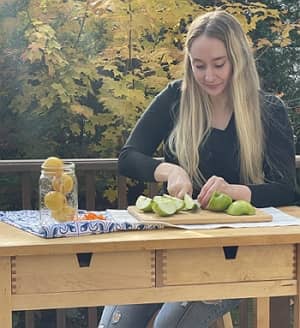Discover simple, sustainable eating habits that can lower your carbon footprint and improve the planet’s health. Learn how plant-based foods, local shopping, and reducing food waste can make a big impact.
In today’s world, the term “sustainable living” is everywhere, and with it comes a lot of jargon. It’s easy to get overwhelmed, but one key concept to focus on is your carbon footprint—essentially the measure of your impact on the planet’s health.
Contents
What Is a Carbon Footprint?
Your carbon footprint refers to the total amount of greenhouse gases (GHG) emitted by your actions, particularly carbon dioxide (CO2). While we often associate carbon footprints with travel and single-use plastics, your diet plays a major role too. The food choices you make, how it’s produced, and where it comes from can significantly impact the environment.

Sustainable Eating: A Key to Reducing Your Carbon Footprint
When it comes to food, there are several ways to make more environmentally-friendly choices:
1. Eat More Plants
This is probably the most familiar advice, and for good reason. A plant-forward diet isn’t just healthier for you—it’s better for the planet. The production of plants has a lower carbon footprint than that of animal products, especially when we focus on biodiversity and choose a variety of crops instead of monocultures like corn, wheat, and soy. Opt for foods grown using agroecological principles, which prioritize soil health and ecosystems.
Quick tip: Start by adding more seasonal vegetables to your plate and advocating for agriculture policies that support diverse, sustainable farming methods.
2. Eat Less Animal Products
While giving up meat is a personal choice, reducing your intake can significantly lower your carbon footprint. For instance, beef production is particularly resource-heavy, generating large amounts of methane—a potent greenhouse gas. And the environmental cost extends to the workers in the meat production industry. Consider lowering your meat consumption and buying from reputable sources that practice humane and sustainable methods.
For more insights into the environmental impact of meat production, check out this Sustainable Food Trust article.
3. Shop Local and Seasonal
Whenever possible, purchase locally-sourced, seasonal produce. This reduces the carbon footprint associated with transportation and supports your local economy. Plus, eating seasonally helps you align with nature, avoiding the environmental costs of growing crops outside their natural season.
Pro tip: Instead of importing strawberries in winter, embrace root vegetables and other produce that naturally thrive in colder months.
4. Reduce Food Waste
According to the EPA, food waste is a significant contributor to GHG emissions. Aim to reduce waste by shopping smart and using leftovers creatively. Start composting if you can, and make stock out of vegetable scraps.
Need some creative tips on food waste reduction? Check out Love Food Hate Waste for more ideas.
Make Small, Lasting Changes
The key to creating long-term change is starting small. Incorporate one new habit a week—whether it’s adding more plants to your diet or committing to zero food waste. Set manageable goals and check in with yourself to stay motivated. Small shifts over time will have a lasting impact on both your health and the environment.
By making these conscious food choices, you’re not just improving your diet—you’re actively contributing to a healthier planet.
To learn more about what Dining With Nature offers for sustainable nutrition care – hit the Explore The DWN Programs button below or take a look at our Services page.

